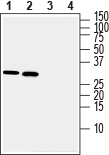Overview
- Peptide (C)EGPWERPPPLDESER, corresponding to amino acid residues 160 - 174 of human DARPP32 (Accession Q9UD71). Intracellular, C-terminus.
- Rat and mouse brain lysates; human U-87 MG glioblastoma and HT-29 colorectal adenocarcinoma cell lysates (1:200-1:1000).
 Western blot analysis of rat brain lysate (lanes 1 and 3) and mouse brain lysate (lanes 2 and 4):1, 2. Anti-DARPP32 Antibody (#ADR-006), (1:200).
Western blot analysis of rat brain lysate (lanes 1 and 3) and mouse brain lysate (lanes 2 and 4):1, 2. Anti-DARPP32 Antibody (#ADR-006), (1:200).
3, 4. Anti-DARPP32 Antibody, preincubated with DARPP32 Blocking Peptide (#BLP-DR006).
- Rat brain sections (1:200).
Dopamine- and cAMP-regulated neuronal phosphoprotein (DARPP32), also known as, Protein phosphatase 1 regulatory subunit 1B (PPP1R1B) is a protein regulated by the phosphorylation of cAMP1.
DARPP32 is expressed in the spiny neurons of the neostriatum and in the adrenal medulla, kidney, and parathyroid cells and it is also overexpressed in tumor cells from breast, colon, esophagus, lung and prostate tissues1,2. Its protein structure is comprised of 18% alpha helix, 23% beta strand, 30% beta turn, and 29% random coil3.
DARPP32 has been shown to play a key role in mediating the biochemical, electrophysiological, and behavioral effects of dopamine on dopaminoceptive neurons4,5. It is also involved in mediating the actions of other neurotransmitter systems such as serotonin and glutamate, in response to a variety of drugs5,6.
DARPP32 is reported to have a role in development and neurodegenerative diseases. In addition, DARPP32 plays a role in cancer tumorigenesis. Collectively, findings from published reports suggest DARPP32 as a potential biomarker of drug resistance and a therapeutic target in gastric cancer and other malignancies5.
